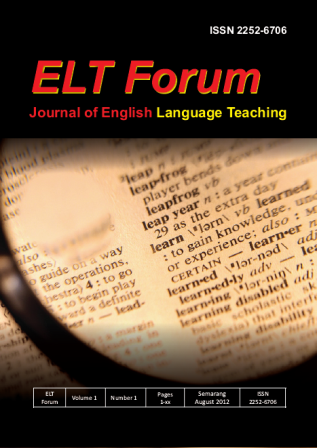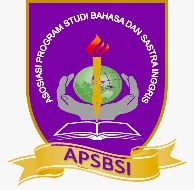THE USE OF JIGSAW II TECHNIQUE AND STILL PICTURES COMBINATION TO IMPROVE STUDENTS’ VOCABULARY MASTERY
Abstract
This article is about the use of Jigsaw II technique and Still Pictures combination to improve students’ vocabulary mastery. In order to achieve the objectives of this research, the writer adopted an action research design. The subject of this research was class 7B of SMP N 12 Magelang, in the academic year of 2012/2013 which consisted of 32 students. There were two cycles in this research, and there were four phases in each cycle. They were planning, action, observation, and reflection. In order to collect data about students’ vocabulary mastery improvement and responses toward the use of this technique and media, the writer used observation sheet, questionnaire, interview, and test. The result of this study showed that the combination of Jigsaw II technique and Still Pictures can improve students’ vocabulary mastery. Besides, the result of the observation sheet, questionnaire and interview revealed that the students gave very positive responses toward the use of this technique and media. Based on the result of this research, the writer concluded that the use of Jigsaw II technique and Still Pictures gave a good contribution in English teaching and learning, especially in the area of vocabulary learning.
References
Ababneh, S. 2013. Strategies Used by Jordanian University Students in Dealing with New Vocabulary in English. Journal of Education and Practice. Vol.4, No.4, 2013. Available at http://www.iiste.org/Journals/index.php/JEP/article/view/4509 [accessed 19/5/13].
Bintz, W.P. 2011. Teaching Vocabulary across the Curriculum. Middle School Journal. Available at http://littoolkit.pbworks.com/f/Middle%2520School%2520Vocabulary%2520Strategies. pdf [accessed 19/5/2013]
Cameron, Lyne. 2001. Teaching Language to Young learners. Cambridge : Cambridge University Press.
Coles, Bobby. 2010. Writing Level Star. Available at: http://www.helium.com/items/ 1927657-vocabulary-learning-vocabulary [accessed 05/02/13]
Gunter, M.A., Estes, T.H., and Mintz, S.L. 2007. Instruction : A Model Approach. Boston: Pearson Education, Inc.
Harmer, J. 2001. The Practice of English language Teaching. England: Pearson Education Limited.
Kalisa, P. 2011. The Improvement of Students Ability in Comprehending Recount Text Through Pictorial Illustration. Final Project English Department FBS Unnes.
Kaptiningrum, Pindha. 2011. The Effectiveness of Jigsaw Method to Improve the Students Show Presenting Skil. Final Project English Department FBS Unnes.
Linse, Caroline T. 2006. Practical English Language Teaching : Young Learners. New York: McGraw Hill.
Mc.Cafferty, S. G., Jacobs, G. M., Iddings, A. C. D. 2006. Cooperative Learning and Second Language Teaching. Cambridge : Cambridge University Press.
Mehta, K.M. 2009. Vocabulary Teaching:Effective Methodologies. The Internet TESL Journal, Vol. XV, No. 3, 2009. Available at http://iteslj.org/Techniques/Mehta-Vocabulary.html. [accessed 19/5/13].
Murcia, M.C. 2001. Teaching English as a Second or Foreign Language. USA: Heinle and Heinle.
Richards, J.C. and Renandya, W.A. 2002. Methodology in Language Teaching :An Anthology of Current Practice. New York: Cambridge University Press.
Rohmah, Nur. 2011. The Use of Internet Picture Dictionary as Media in Teaching Vocabulary. Final Project English Department FBS Unnes.
Slavin, R.E. 1995. Cooperative Learning. Boston: Allyn and Bacon.
Tschirner, Erwin. 2004. Breadth of Vocabulary and Advanced English Study: An Empirical Investigation. Electronic Journal of Foreign Language Teaching. Vol. 1, No. 1, pp. 27-39. Available at http://e-flt.nus.edu.sg/v1n12004/tschirner.pdf [accessed 19/02/13].
Werff, J. 2003. Using Pictures from Magazines. The Internet TESL Journal, Vol. IX, No.7.
Available at http://iteslj.org/Techniques/Werff-Pictures.html. [accessed 19/5/13]



_.jpg)
_.jpg)




